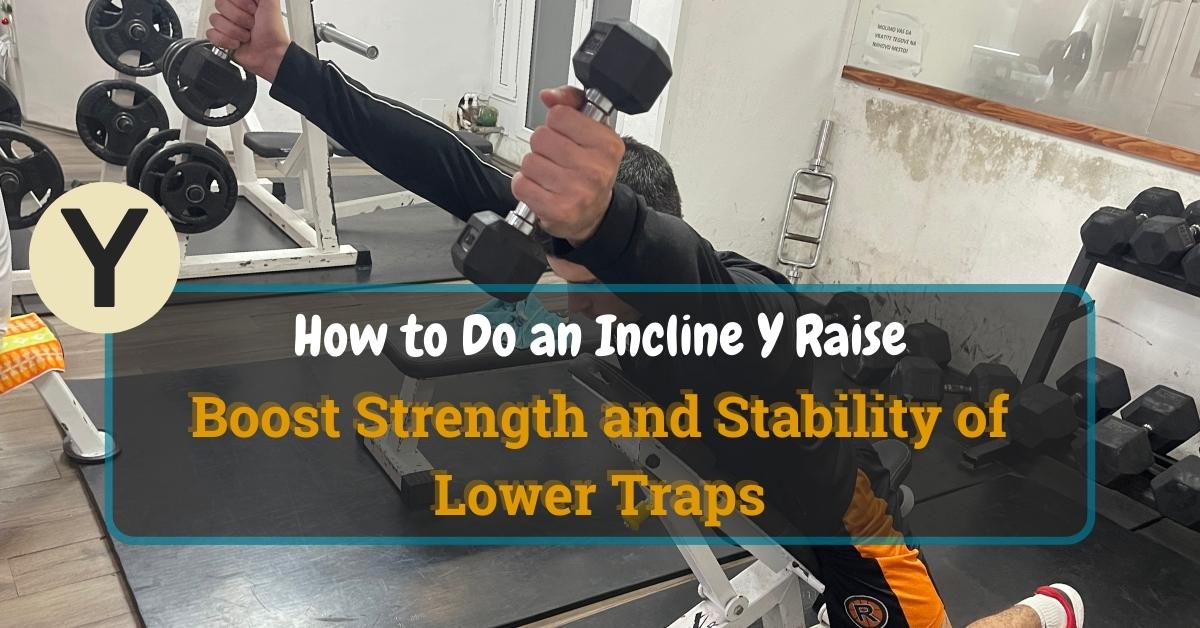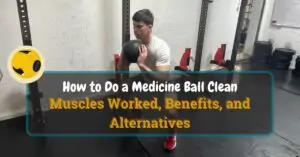The incline Y raise, or chest supported Y raises as some call it, is a gold standard when it comes to lower trapezius strengthening. In fact, a study on PubMed confirms this by concluding that exercises performed above 90° of shoulder elevation are excellent recruiters of the lower trapezius [1].
Table of Contents
ToggleSo, chest supported Y raises are phenomenal for improving both the strength and stability of your lower traps, shoulders, and scapula (shoulder blades).
But why do you even need strong lower traps in the first place?
You need strong lower traps because they will promote healthy posture and good form during all sorts of overhead movements, such as overhead presses, incline presses, and pull-ups.
To perform incline Y raises properly to maximize performance, I created an easy-to-follow step-by-step guide below. It covers everything from programming guidelines, muscles worked during chest supported Y raises, benefits, tips, most common mistakes, variations, and best alternatives.
Ready to improve your lower trap strength for better performance of all overhead exercises?
Let’s start with the guide below.
Start Building Your Dream Body Today
Ready to elevate your fitness game without falling into the trap of dull, repetitive routines that just don’t deliver? Imagine sculpting your ideal physique and boosting your health, all while still enjoying life’s pleasures, like those irresistible weekend getaways and your aunt’s legendary cheesecake. With our online fitness and nutrition coaching service, you don’t have to compromise. Dive into a personalized fitness journey that blends perfectly with your lifestyle, not against it. Book your completely free discovery consultation today, and take the first step towards a transformation that doesn’t require giving up the joys of life.

“I was skeptical about online fitness coaching, but Functional Body Savage completely changed my perspective. Vanja and Radomir’s personalized approach and attention to detail have helped me achieve goals I never thought possible. I’m stronger, more confident, and grateful for their guidance.”
Emily Thompson, San Francisco, CA
Learn More About Our Online Coaching ServiceQuick Summary
- To perform an incline Y raise, lie on your stomach on an inclined bench, lift your arms in a ‘Y’ shape while maintaining alignment, and control the movement with focused muscle engagement.
- A study on PubMed confirms that exercises performed above 90° of shoulder elevation, like the incline Y raise, are excellent for recruiting the lower trapezius muscles.
- Through dedicated study and application in this area, I’ve discerned that incorporating incline Y raises into regular workout routines significantly improves upper body strength and posture and aids in injury prevention.
How to Do an Incline Y Raise: Step-By-Step Guide
Here is a simple guide about performing incline Y raises below.
Step One — Lie on Your Stomach on the Incline Bench
Position an incline bench at about a 30 to 45-degree angle. Lie down on your stomach on the bench, ensuring your chest is firmly against the pad and your feet are flat on the ground for stability. Lift your collarbone from the surface of the bench and slightly pinch and retract your shoulder blades (scapula) to make your arms “lighter.”
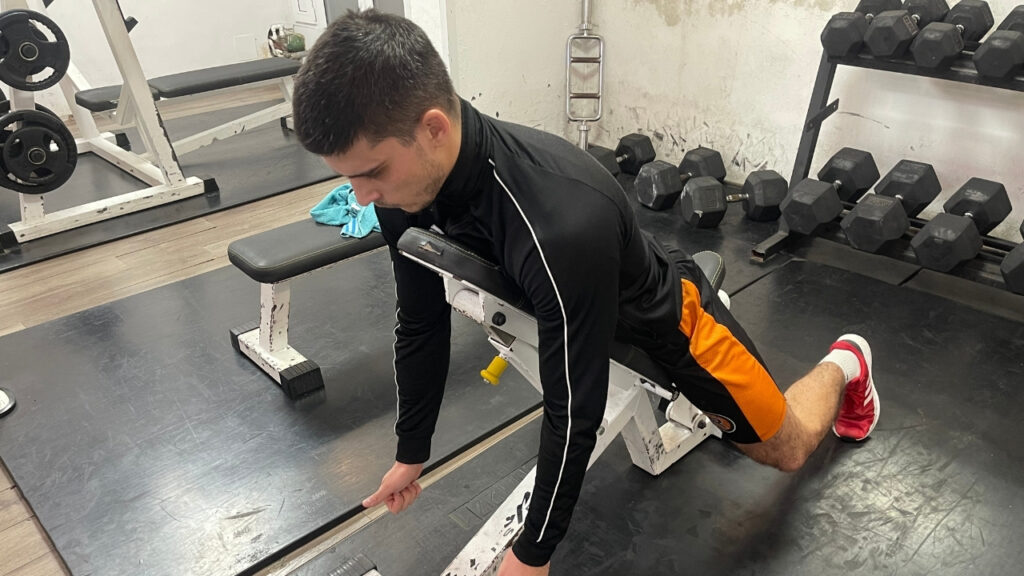
Pro Tip: Make sure your neck is in a neutral position, aligned with your spine, to avoid strain. Adjust the bench so that your arms can move freely without touching the floor at the bottom of the movement.
Step Two — Lift Your Arms in the Y Shape
Extend your arms forward so they form a ‘Y’ shape with your body. With your thumbs pointing upwards, lift your arms straight until they are in line with your body. At the top position, hold for one second and make sure to retract and squeeze your shoulder blades.
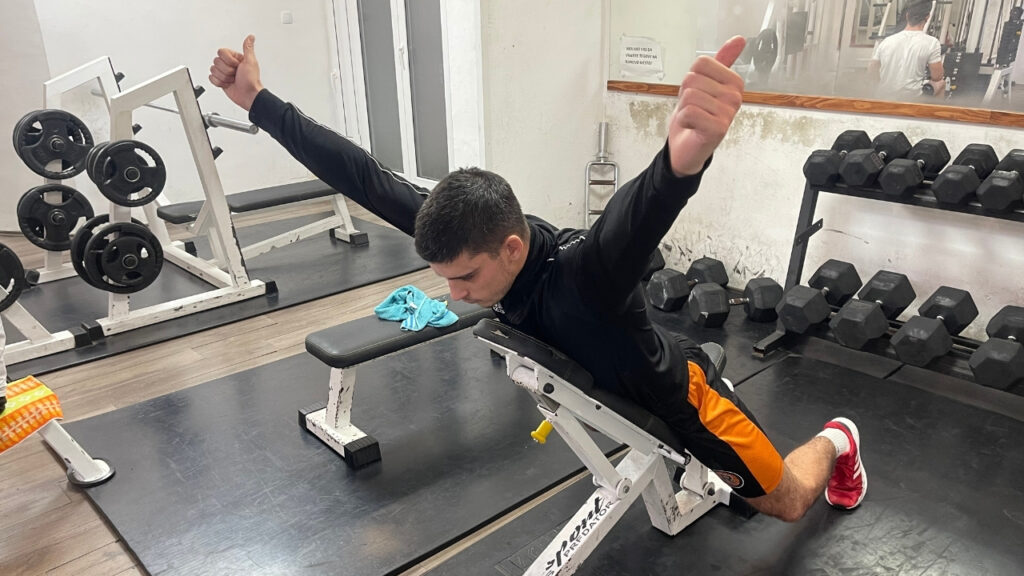
Pro Tip: Focus on moving your arms using the muscles in your upper back and shoulders, not momentum. Keep the movement smooth and controlled, lifting your arms to a height where your muscles are engaged but not strained.
Step Three — Lower Your Arms to the Starting Position
Gradually return your arms to the beginning position in a controlled manner. Ensure that your movements are steady and that you maintain the ‘Y’ shape throughout.
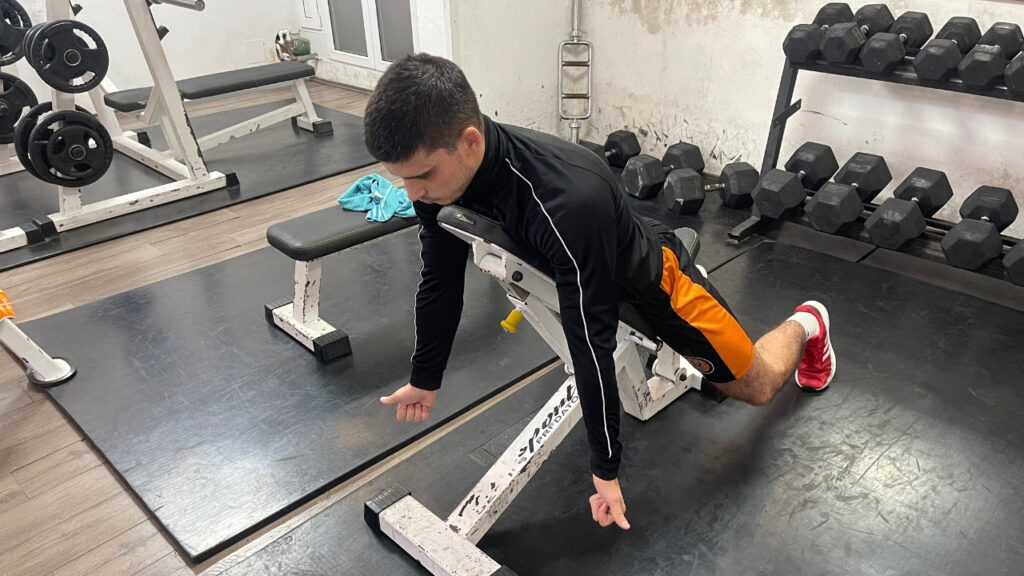
Pro Tip: As you lower your arms, inhale and focus on the lowering (eccentric) portion of the lift, as this part is crucial for muscle development. Resist the temptation to let gravity do the work; control is key.
How to Program Chest Supported Y Raises
Programming chest-supported Y raises effectively requires integrating them into your upper body or shoulder-focused workouts. Typically, they should be performed after compound exercises like bench presses or overhead presses. Complete 2-3 sets of 10-15 repetitions, focusing on form and control rather than heavy weights.
These raises are best utilized as a supplementary exercise with the aim of targeting the rear deltoids and upper back muscles, enhancing overall shoulder health and posture. Incorporate them once or twice a week, ensuring proper rest between sessions to allow for better muscle recovery.
Gradually increase the weight or reps as you progress, but always prioritize technique over the external load. Additionally, consider pairing them in supersets with exercises that target opposing muscle groups, like chest or lateral deltoids, for balanced shoulder development.
You can also include them in your warm-up sessions where they are suitable and biomechanically similar to the exercises you are going to perform in the workout ahead. Remember, consistency and gradual progression are key to seeing improvements in strength and muscle balance.
Incline Y Raise Muscles Worked
Based on my biomechanical analysis of the incline Y raise movement, the primary muscles working are:
- Posterior deltoid
- Lower trapezius
- Rhomboids
Also, the secondary muscles working are:
- Supraspinatus
- Infraspinatus
- Teres minor
- Subscapularis
- Levator scapulae
- Serratus anterior
Incline Y Raise Benefits
Below are the most notable incline Y raise benefits.
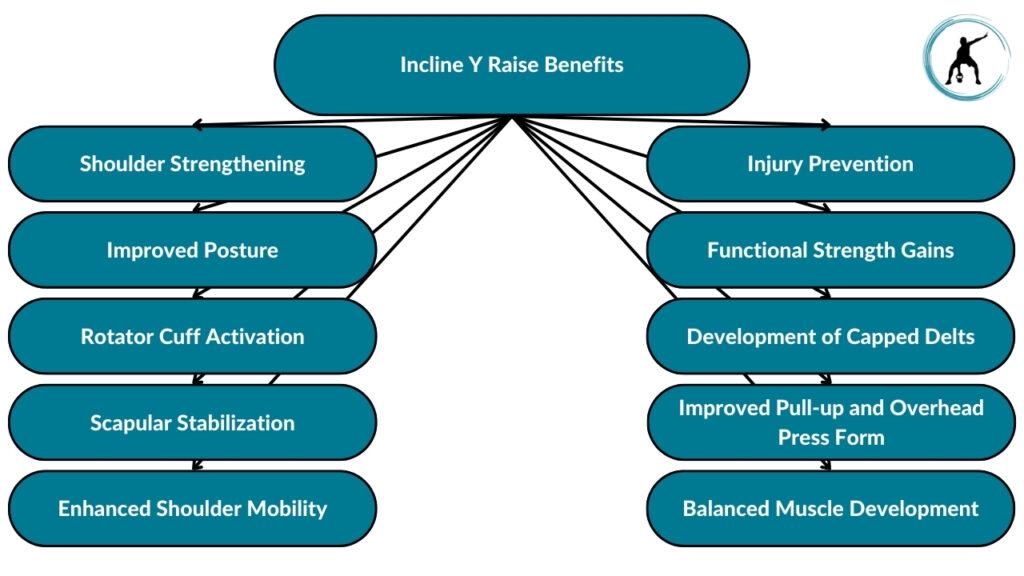
Shoulder Strengthening
The incline Y raise primarily targets the posterior deltoids, effectively strengthening the shoulder muscles. This leads to improved overall shoulder function and health.
Improved Posture
By strengthening the upper back muscles, such as the lower trapezius and rear shoulder muscles, this exercise helps in correcting rounded shoulders, a common issue with sedentary lifestyles, thus improving posture.
A study from PubMed Central found that sedentary adults tend to experience faulty postures, including rounded shoulders and forward head postures [2]. This practically makes Y raises a must-do exercise as you get older to preserve proper posture and physical health.
Rotator Cuff Activation
The movement pattern of the incline Y raise engages the rotator cuff muscles, which are key in stabilizing and protecting the shoulder joint.
Scapular Stabilization
This exercise strengthens the muscles around the scapula, such as traps, rhomboids, levator scapulae, and serratus anterior (shoulder blade). This enhances the stability of the shoulder girdle, which is crucial for upper-body movements.
Enhanced Shoulder Mobility
Regular practice of the incline Y raise can lead to increased shoulder mobility, making it easier to perform a variety of daily and athletic movements, especially overhead activities.
Injury Prevention
Strengthening the shoulder and upper back muscles through this exercise can reduce the risk of common shoulder injuries, particularly those related to rotator cuff and posture issues.
Functional Strength Gains
The incline Y raise contributes to functional strength, which is beneficial for activities requiring lifting, pushing, or pulling.
Development of Capped Delts
This exercise helps in developing the posterior aspect of the deltoids. According to the bodybuilding legend John Meadows, aka “Mountain Dog,” this contributes to a more balanced and aesthetically pleasing shoulder appearance, often referred to as ‘capped delts.’
Improved Pull-up and Overhead Press Form
Stronger rear deltoids and lower trapezius muscles developed through this exercise can enhance performance and form in exercises like pull-ups and overhead presses. This is because the lower trapezius is responsible for stabilizing shoulder blades during overhead movements.
Balanced Muscle Development
Incline Y raises ensure a balanced development of shoulder muscles, preventing muscle imbalances that can arise from focusing only on front and side deltoids.
What Are the Best Tips for Performing an Incline Y Raise?
Here are the best tips for performing an incline Y raise.
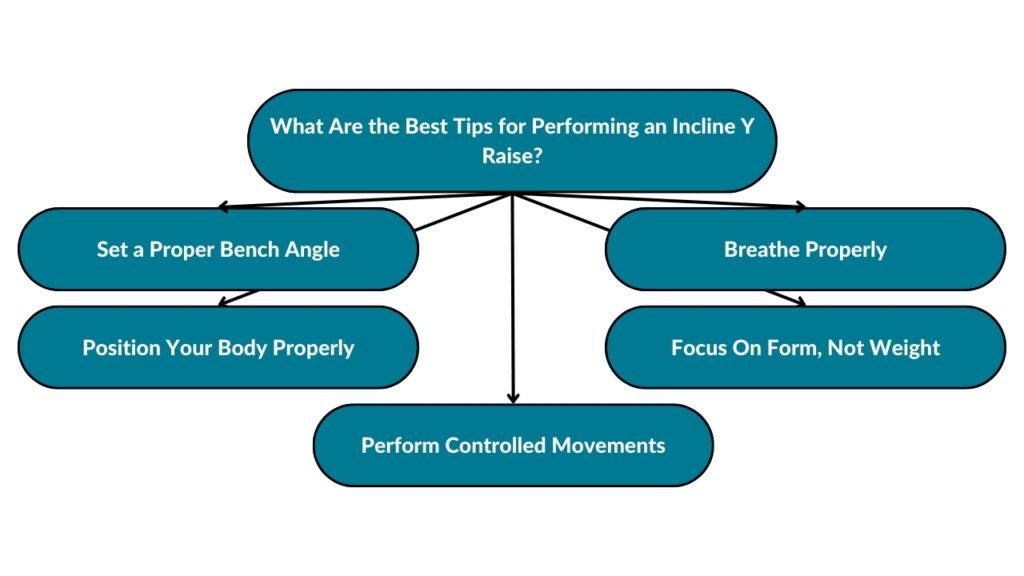
Set a Proper Bench Angle
To effectively target the right muscles, set the incline bench at a 30-45-degree angle. This angle is ideal for engaging the upper back and shoulder muscles without putting undue stress on your neck.
Position Your Body Properly
Lie face down on the bench with your chest firmly against the pad. Ensure your feet are flat on the ground for stability. Your body should be aligned straight from head to heels, with your neck in a neutral position. Lift your collarbone and retract your shoulder blades at the beginning of the exercise.
Perform Controlled Movements
Lift your arms and weights if you use them in a smooth, controlled manner to form a ‘Y’ shape with your body. You mustn’t have momentum to lift the weights; instead, focus on engaging upper back muscles and shoulders. Slowly lower the dumbbell weights back to the starting position, following the same principles.
Breathe Properly
Coordinate your breathing with your movements for better rhythm and stability. Inhale as you lower the weights and quickly exhale as you lift them. Proper breathing not only helps maintain a good tempo but also aids in muscle activation and stability.
Focus On Form, Not Weight
Start with lighter external resistance to ensure you can perform the exercise with proper form. It’s more beneficial to do the exercise correctly with lighter weights than to compromise your form with heavier weights. As you progress, feel free to increase the weight while maintaining good technique gradually.
What Are the Most Common Mistakes During Chest Supported Y Raises?
Below, you may find the most common mistakes during chest supported Y raises.
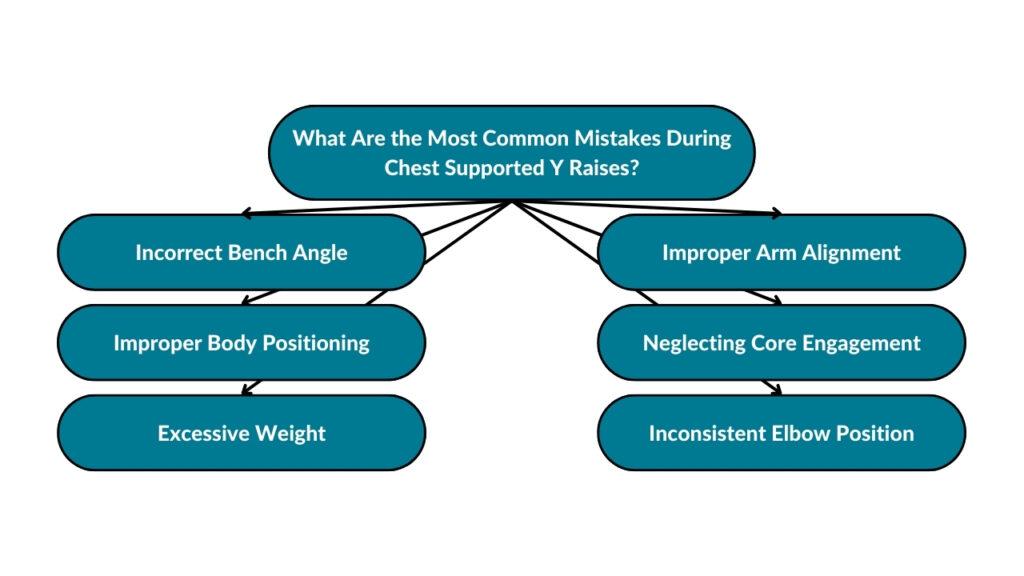
Incorrect Bench Angle
Setting the bench at an incorrect angle can significantly affect the effectiveness of the exercise. An angle too steep or too flat won’t target the intended muscles properly, reducing the exercise’s benefits.
Improper Body Positioning
Not lying correctly on the bench can lead to ineffective muscle engagement and potential strain. Your chest should be firmly against the pad, and your body should be aligned straight. Incorrect positioning can also put undue stress on the neck and lower back.
Excessive Weight
Using weights and dumbbells that are too heavy for this exercise can lead to compromised form. This reduces its effectiveness and increases the risk of injury. It often leads to using momentum rather than muscle engagement to lift the weights.
Improper Arm Alignment
Failing to maintain a proper ‘Y’ shape with your arms can shift the focus away from the target muscles. Arms should be aligned with the ears, and thumbs should be pointing upwards to ensure correct muscle engagement.
Neglecting Core Engagement
Don’t forget to engage your core muscles since that often leads to a lack of stability and support for the lower back. A strong, engaged core helps maintain proper form and enhances the effectiveness of the exercise.
Inconsistent Elbow Position
Bending the elbows excessively or altering their position during the entirety of the exercise can shift the focus away from the intended muscle groups. Keeping the arms straight ensures that the rear deltoids and upper back muscles are effectively targeted.
Incline Y Raise Variations
Here are the best incline Y raise variations, at least based on my gym experience.
Incline Y Raise With Dumbbells
This variation utilizes dumbbells to perform the Y raise on an incline bench, targeting the upper back and shoulder muscles effectively.
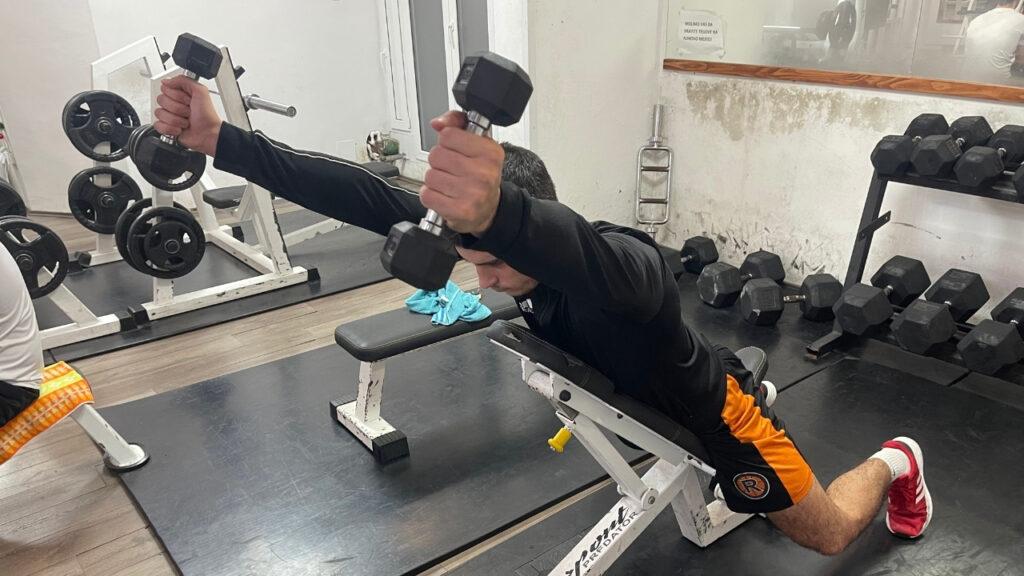
Exercise instructions:
- Set the incline bench to an angle of 45 degrees.
- Lie face down with your chest firmly against the bench, feet flat on the ground for stability.
- Hold a dumbbell in each hand, arms extended forward, palms facing each other.
- Raise the dumbbells in a controlled manner, maintaining straight arms to create a Y shape.
- Gradually lower the dumbbells down to the initial position, ensuring control during the entire motion.
Pro Tip: Focus on slow, controlled movements to maximize muscle engagement. Ensure your arms remain in line with your ears throughout the exercise to target the rear deltoids effectively.
Dumbbell Y Raise Standing
The standing version of the Y raise challenges your core stability and overall balance while working the shoulders and upper back.
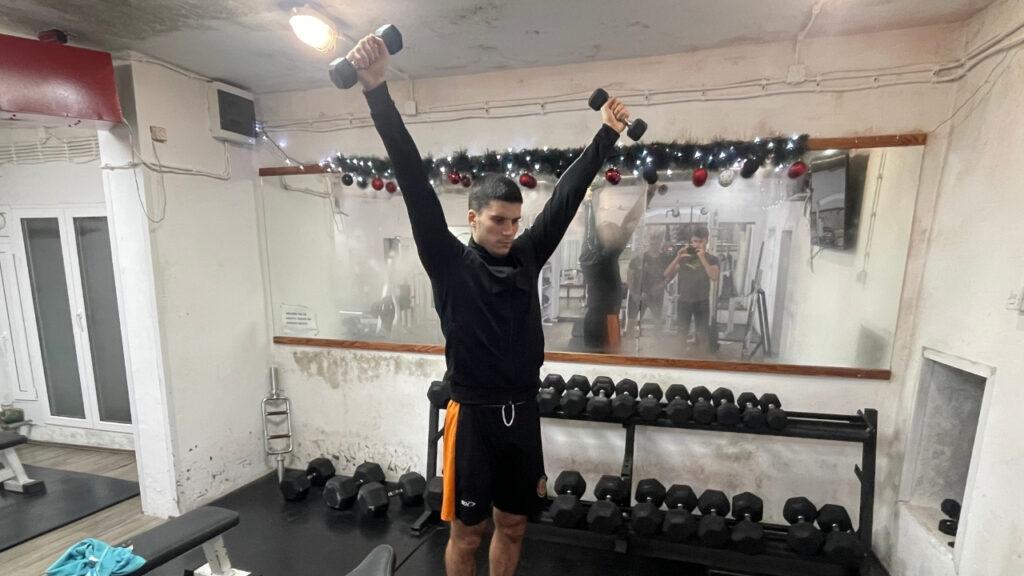
Exercise instructions:
- Position yourself with feet spaced shoulder-width and knees gently bent to ensure stability.
- Hold a dumbbell in each hand in front of you, palms facing each other.
- Engage your core musculature and maintain a straight back.
- Elevate your arms outward to create a Y formation, maintaining straightness in your arms.
- Then, in a controlled way, return the dumbbells to the initial position.
Pro Tip: Engage your core musculature throughout the exercise to maintain balance and stability. Keep your movements controlled to prevent using momentum instead of muscle strength.
Prone Y Raise on a Stability Ball
Performing the Y raise on a stability ball will add an element of instability. This will further engage your core muscles and improve balance.
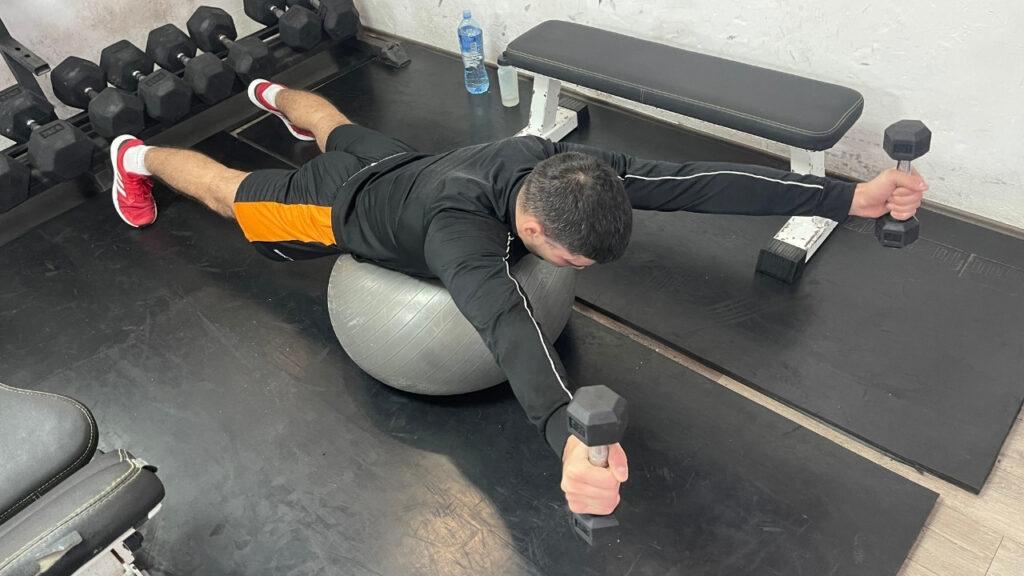
Exercise instructions:
- Position a stability ball and lie prone on it, stabilizing your lower body with your toes on the ground.
- Hold a dumbbell in each hand, arms extended forward.
- Keep your neck neutral and align your spine.
- Perform the Y raise by lifting your arms up and out, maintaining a controlled motion.
- Gradually return the dumbbells to their initial position.
Pro Tip: Keep your spine neutral and engage your glutes to maintain stability on the ball. This variation enhances core engagement, so focus on controlled movements.
Flat Bench Y Raise
The flat bench Y raise slightly alters the muscle engagement compared to the incline version.
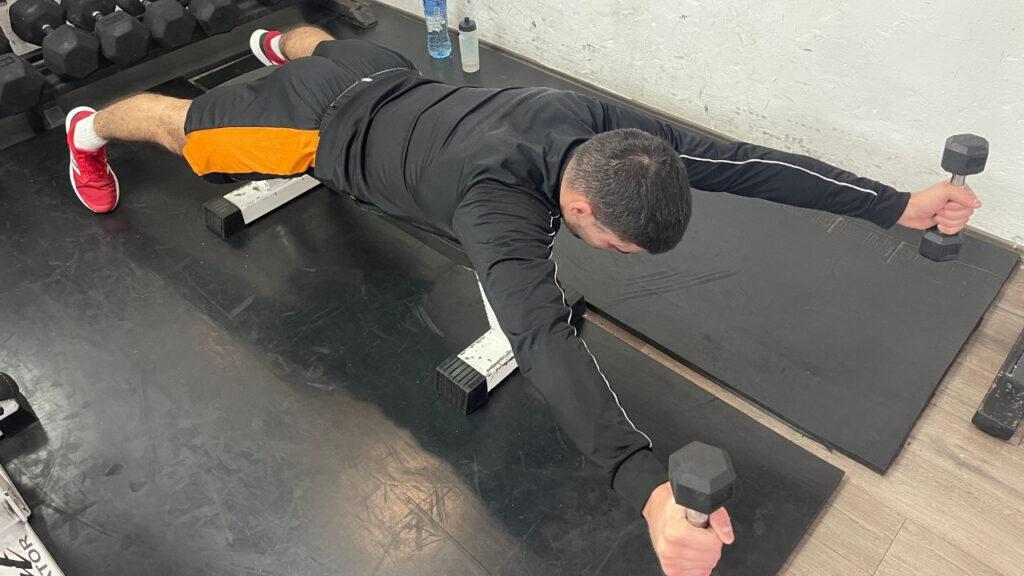
Exercise instructions:
- Lie face down on a flat bench.
- Extend your arms forward while holding the weight in each hand and making your palms face each other.
- Keep your feet grounded and spine aligned.
- Bring your arms up and out. Form a Y shape, and keep them straight.
- Lower the dumbbells back to the starting position in a controlled manner.
Pro Tip: Ensure your neck remains in line with your spine to avoid strain. This variation targets the mid and lower traps more intensely.
Cable Machine Y Raise
Using a cable machine for Y raises provides constant tension throughout the movement.
Exercise instructions:
- Set the pulleys on a cable machine to the lowest setting and attach handles.
- Stand facing the machine; feet shoulder-width apart for stability.
- Grip both handles with your palms facing each other.
- Perform the Y raise motion, lifting your arms up and out in a controlled manner.
- Return to the starting position with utmost control, maintaining tension on the cables.
Pro Tip: The constant tension from the cables enhances muscle activation. Keep your core engaged and focus on a full range of motion for maximum effectiveness.
Y Raise With Suspension Trainer
This variation uses body weight as resistance, making it a functional and challenging exercise.
Exercise instructions:
- Adjust the TRX or suspension trainer to an appropriate height.
- Grasp the handles and lean forward into a plank position, feet shoulder-width apart.
- Keep your body straight and core engaged.
- Perform the Y raise motion by lifting your arms up and out, maintaining control.
- Slowly return to the beginning position, keeping tension in your shoulder and upper back.
Pro Tip: Alter your body angle to adjust the difficulty. This variation not only targets the upper back and shoulders but also significantly engages the core.
Incline Y Raise Alternative Exercises
Here are some of the best incline Y raise alternatives to try.
Face Pulls
In my experience, face pulls are an excellent exercise for targeting the rear deltoids, upper back, and rotator cuff muscles. They are excellent at enhancing shoulder health and posture.
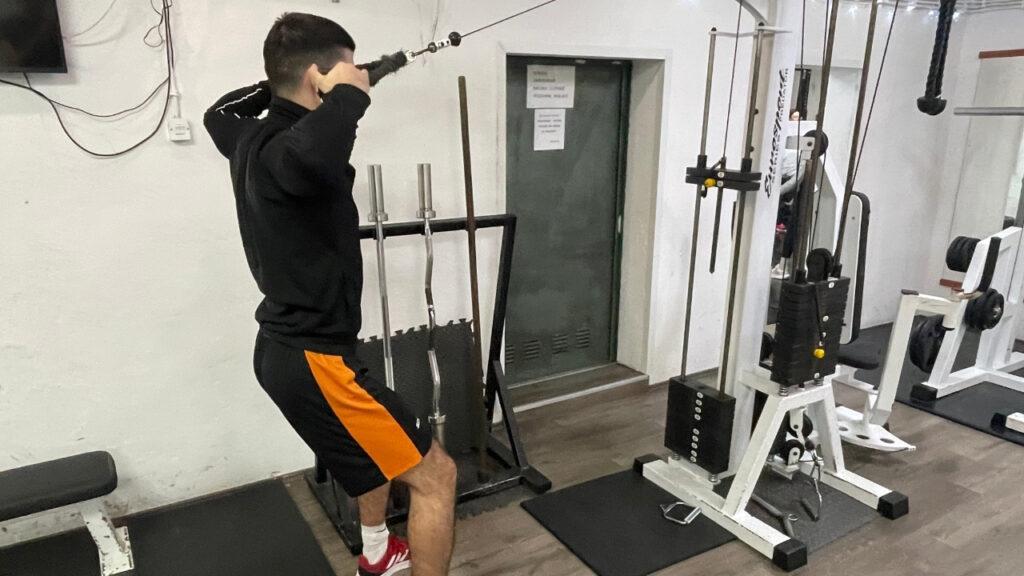
Exercise instructions:
- Connect a rope attachment to a cable machine positioned at upper chest height.
- Stand facing the machine, grab the rope with both hands, palms facing each other.
- Step backward to generate tension in the cable, and adopt a staggered stance for balance.
- Draw the rope towards your face, parting your hands as you do so.
- Maintain elevated elbows and contract your shoulder blades together at the peak of the motion.
- Slowly return to the starting position, maintaining control.
Pro Tip: Focus on squeezing your shoulder blades together to maximize engagement of the upper back muscles. Keep the movement controlled, avoiding using momentum.
Incline I Raise
The incline I raise primarily targets the front and middle deltoids, as well as the upper back, and is performed on an incline bench.
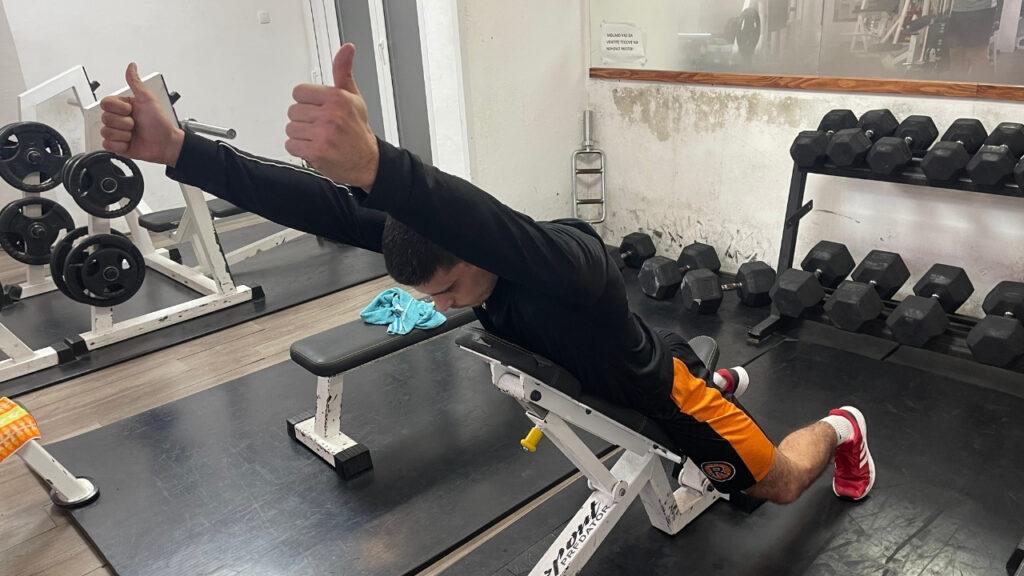
Exercise instructions:
- Adjust the bench to an angle of 30 to 45 degrees.
- Position yourself face down on the bench, holding a dumbbell in each hand.
- Extend your arms in front and up, creating an ‘I’ shape with your body.
- Elevate the dumbbells to the height of your body, then smoothly lower them back.
- Maintain a neutral neck position and engage your core during the exercise.
Pro Tip: Ensure your movements are slow and controlled, focusing on the shoulder muscles. Avoid lifting the weights too high, which can put unnecessary stress on the shoulder joints.
Incline T Raise
The incline T raise is effective for targeting the middle and rear deltoids, as well as the upper back, and is performed on an incline bench.
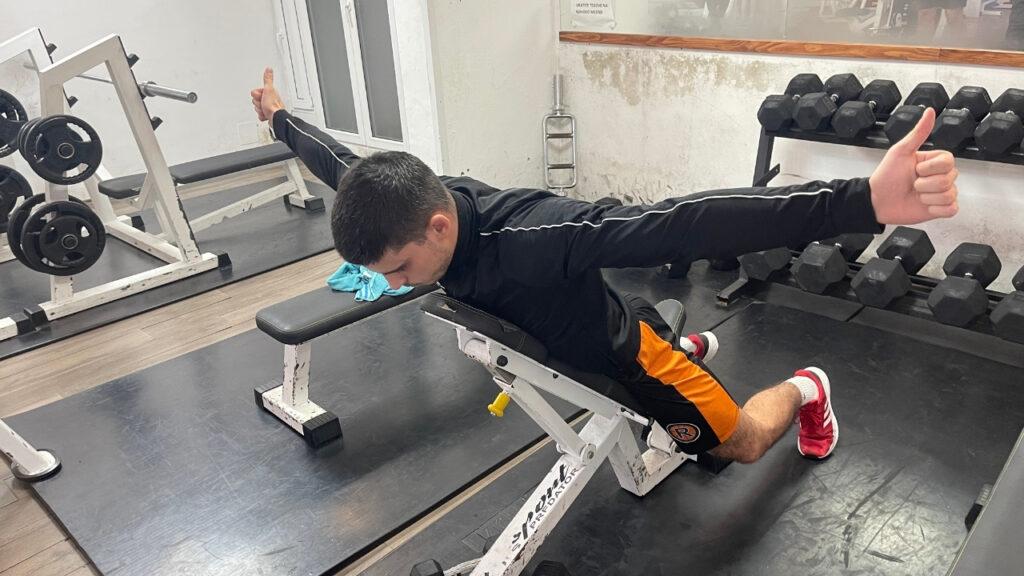
Exercise instructions:
- Set up the incline bench at a 45-degree angle to prepare for the exercise.
- Position yourself face down on the bench, ensuring you’re comfortable and stable.
- Grasp a dumbbell in each hand, holding them at your sides while lying on the bench.
- Extend your arms outward to the sides, creating a ‘T’ shape with your body for proper alignment.
- Carefully elevate the dumbbells up to the height of your shoulders, focusing on a smooth, steady lift.
- After reaching shoulder height, gently and with control, lower the dumbbells back to the starting position.
- Make sure to maintain a neutral neck position and keep your core muscles engaged to support your spine and enhance the effectiveness of the movement.
Pro Tip: Focus on lifting with your shoulders and upper back, not your arms. Control the descent to maximize muscle engagement and prevent injury.
Incline W Raise
The incline W raise targets the rear deltoids and upper back, emphasizing scapular retraction, and is a great posture-correcting exercise.
You can also try a more advanced alternative to this exercise, which is the prone ball cobra on a stability ball.

Exercise instructions:
- Adjust the incline to about a 45-degree angle.
- Lie face down on the bench with a dumbbell in each hand.
- Flex your elbows to form a ‘W’ shape with your arms.
- Lift the dumbbell weights while squeezing your shoulder blades together.
- Slowly return to the starting position, maintaining the ‘W’ shape.
Pro Tip: Keep your elbows bent and focus on the movement of your shoulder blades to fully engage the upper back. This exercise is not about lifting heavy but about precision and control.
FAQs
What Are the Benefits of Prone Y Lifts?
The benefits of prone Y lifts include improved shoulder stability and enhanced upper back strength. This workout focuses on the upper back and shoulder muscles, specifically targeting the lower trapezius and rotator cuff muscles, which contributes to improved posture and a decreased likelihood of shoulder injuries.
What Does Cable Y Raises Work?
Cable Y raises work primarily on the shoulder muscles, specifically targeting the deltoids and upper trapezius. This exercise strengthens and stabilizes the shoulder muscles, which are essential for functional upper-body movements.
What Is the Angle of the Y Raise?
The angle of the Y raise is typically set between 30 and 45 degrees on the bench incline. This specific angle range is crucial as it optimally engages the shoulder muscles, particularly the deltoids and lower trapezius, for effective strengthening and conditioning.
What Are the Benefits of Iyt Raises?
The benefits of IYT raises include enhanced shoulder stability and improved posture. These exercises target a range of muscles in the shoulders and upper back, such as the deltoids, trapezius, and rotator cuff muscles, leading to better overall shoulder health and function.
What Is the Difference Between a Trap 3 Raise and a Y Raise?
The difference between a Trap 3 raise and a Y raise lies in the muscle focus and arm positioning. Trap 3 raises specifically target the lower trapezius muscles with the arm positioned in line with the body. In contrast, Y raises engage a broader range of shoulder muscles, including the deltoids and upper trapezius, with arms forming a ‘Y’ shape.
What Is the Difference Between Face Pulls and Y Raises?
The difference between face pulls, and Y raises is in the muscle engagement and exercise execution. The face pull exercise primarily works the rear deltoids and upper back muscles through a pulling motion directed toward the face. In contrast, Y raises focus on the deltoids and upper trapezius muscles through an upward lifting motion in a ‘Y’ shape.
What Is the Bent Over Y Exercise?
The bent over Y exercise is a strength training movement focusing on the shoulders and upper back. In this exercise, the individual bends forward at the hips and lifts the arms into a ‘Y’ shape, effectively engaging the deltoids, trapezius, and rotator cuff muscles for improved shoulder stability and posture.
Wrapping Up
The incline Y raise is a highly effective exercise for strengthening the lower trapezius, posterior deltoids, and upper back muscles, contributing significantly to improved shoulder stability and posture.
Whether you’re looking to enhance your performance in overhead activities, prevent shoulder injuries, or simply improve your posture, the incline Y raise is an invaluable addition to your fitness regimen.
Keep in mind that regular practice and correct technique are essential to fully benefit from this exercise, making it a fundamental routine for those aiming to strengthen and balance their upper body.
Start Building Your Dream Body Today
Ready to elevate your fitness game without falling into the trap of dull, repetitive routines that just don’t deliver? Imagine sculpting your ideal physique and boosting your health, all while still enjoying life’s pleasures, like those irresistible weekend getaways and your aunt’s legendary cheesecake. With our online fitness and nutrition coaching service, you don’t have to compromise. Dive into a personalized fitness journey that blends perfectly with your lifestyle, not against it. Book your completely free discovery consultation today, and take the first step towards a transformation that doesn’t require giving up the joys of life.

“I was skeptical about online fitness coaching, but Functional Body Savage completely changed my perspective. Vanja and Radomir’s personalized approach and attention to detail have helped me achieve goals I never thought possible. I’m stronger, more confident, and grateful for their guidance.”
Emily Thompson, San Francisco, CA
Learn More About Our Online Coaching ServiceReferences:
- Garcia JF, Herrera C, Maciukiewicz JM, Anderson RE, Ribeiro DC, Dickerson CR. Variation of muscle recruitment during exercises performed below horizontal arm elevation that target the lower trapezius: A repeated measures cross-sectional study on asymptomatic individuals. J Electromyogr Kinesiol. 2023;70:102777. doi:10.1016/j.jelekin.2023.102777
- Kang FJ, Lin KY. Observing the effect of physical activity on forward head posture and rounded shoulder posture in young healthy adults. J Phys Ther Sci. 2023;35(8):564-567. doi:10.1589/jpts.35.564

